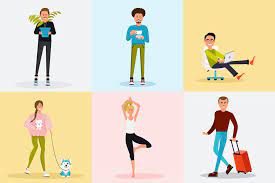The Therapeutic Potential of Art: A Multifaceted Exploration of Well-being
For centuries, art has transcended linguistic limitations, offering a profound means of conveying emotions and experiences. This exploration examines the transformative capacity of art as a therapeutic modality, focusing on its multifaceted contributions to individual well-being and self-discovery. We will investigate how various art-based interventions can be applied to address diverse psychological and emotional challenges. Key concepts such as art therapy, self-efficacy, and the stress-buffering hypothesis will be central to this analysis.
Art Therapy and Emotional Processing: Art therapy, grounded in the principles of psychodynamic theory and humanistic psychology, provides a non-verbal avenue for emotional expression and processing. The creative process acts as a catalyst, enabling individuals to explore and externalize their internal world in a safe and controlled therapeutic environment. This approach leverages the power of symbolism and metaphor to facilitate deeper self-understanding and promote emotional regulation, particularly beneficial in addressing trauma, grief, or anxiety. In a real-world scenario, art therapy sessions could involve creating collages to represent feelings associated with a traumatic event or sculpting clay to express repressed anger. The therapeutic relationship serves as a critical element, allowing for interpretation of the created work within a supportive framework of trust and understanding.
Self-Efficacy and Empowerment Through Creation: Albert Bandura's Social Cognitive Theory highlights the role of self-efficacy – the belief in one's capabilities to succeed – in influencing behavior and well-being. Engaging in artistic creation fosters a sense of mastery and accomplishment, thereby boosting self-efficacy. The tangible outcome of artistic expression provides concrete evidence of one's abilities, promoting self-confidence and a sense of agency. For instance, an individual learning pottery might initially feel inadequate but, as they progress and create functional or aesthetically pleasing pieces, their self-belief and competence will increase. This enhanced self-efficacy can then generalize to other areas of their lives.
Stress Reduction and the Stress-Buffering Hypothesis: The stress-buffering hypothesis suggests that certain coping mechanisms can mitigate the negative impact of stress. Engaging in artistic activities can serve as a potent stress buffer. The focused attention required for creative pursuits acts as a form of mindfulness meditation, promoting relaxation and reducing the physiological symptoms associated with stress, such as elevated heart rate and cortisol levels. Consider the example of a medical professional using knitting as a de-stressing activity after a demanding work shift. The rhythmic nature of knitting, combined with focused attention on the task, helps them regulate their emotional state and promote relaxation. This demonstrates a practical application of the stress-buffering hypothesis through art-based interventions.
Social Connection and Community Building: Participation in art-based groups or classes fosters social interaction and a sense of belonging. Shared creative experiences create opportunities for connection, reducing feelings of isolation and promoting social support. For example, a community art program for senior citizens could enhance their social well-being by providing opportunities for interaction and shared creative activities. This addresses a key aspect of well-being highlighted by Self-Determination Theory, emphasizing the importance of relatedness and social connection.
Self-Discovery and Personal Growth: The process of artistic expression encourages self-exploration and self-discovery. By engaging with diverse art forms, individuals can discover hidden talents, explore different facets of their personality, and gain a deeper understanding of their values and beliefs. This process aligns with the principles of positive psychology which emphasizes personal growth and self-actualization. An individual exploring different art forms, for example, may find a particular medium that resonates deeply, leading to insights into their personality and preferences. This underscores the inherent potential of art for self-discovery and growth.
Cognitive Benefits and Problem-Solving: Creative activities require problem-solving, planning, and critical thinking. The process of translating ideas into tangible art forms strengthens cognitive abilities, promoting flexibility, adaptability, and innovative thinking. For example, the challenge of creating a realistic portrait requires careful planning, observation, and a problem-solving approach to overcome technical challenges. This illustrates the practical application of creative activities in enhancing cognitive function and problem-solving skills.
Conclusion and Recommendations: Art-based interventions demonstrate significant potential for enhancing individual well-being and addressing a range of psychological challenges. By leveraging its therapeutic and empowering properties, we can foster self-efficacy, improve emotional regulation, and build stronger social connections. Further research should investigate the efficacy of art therapy in diverse populations and contexts. This could include exploring the use of art-based interventions in healthcare settings, educational programs, and community initiatives. The integration of art-based therapeutic approaches into mainstream healthcare and educational systems holds significant promise for promoting mental well-being and enhancing personal growth across diverse communities. A multidisciplinary approach, incorporating perspectives from psychology, art therapy, and social sciences, will prove essential for advancing this field of study and translation of research into practical applications.
Reader Pool: Considering the multifaceted benefits outlined in this article, how might the integration of art-based interventions into different societal structures further improve individual and collective well-being?




No comments yet. Be the first to share your thoughts!